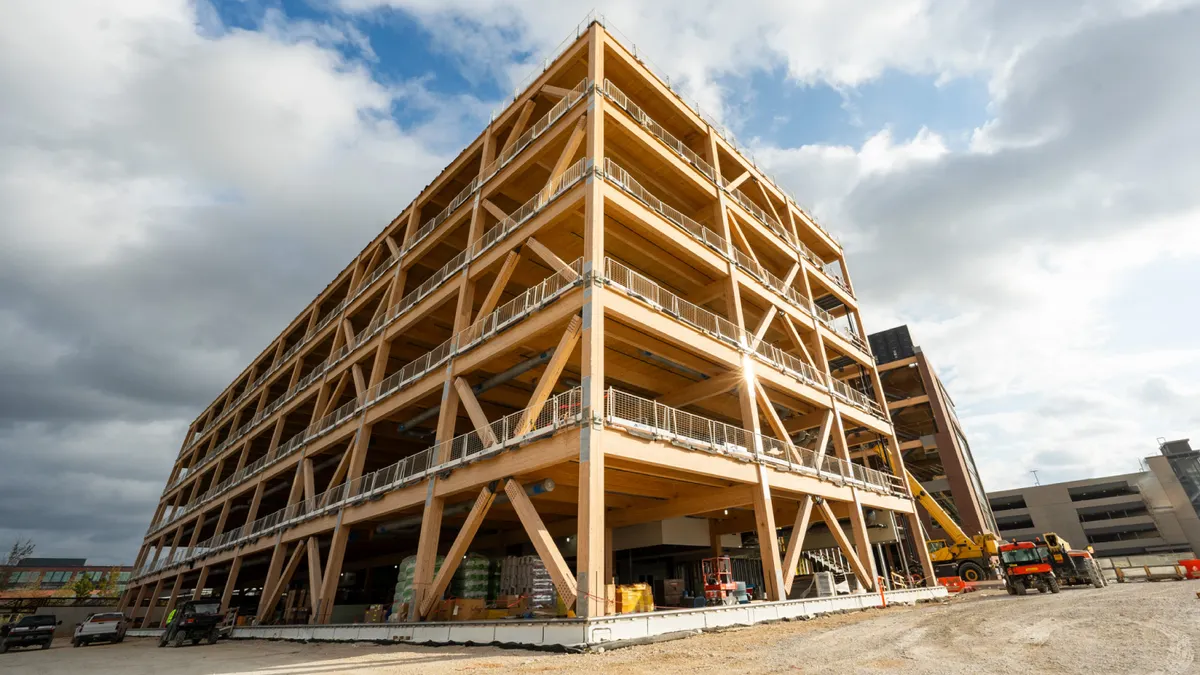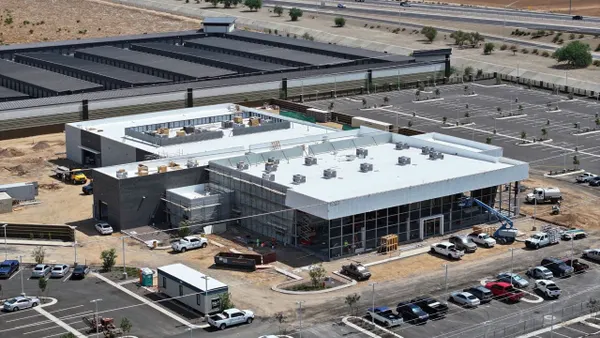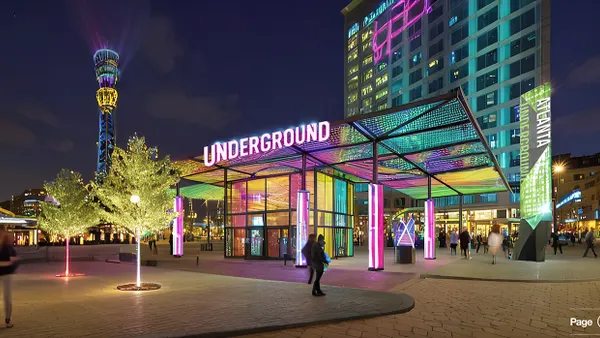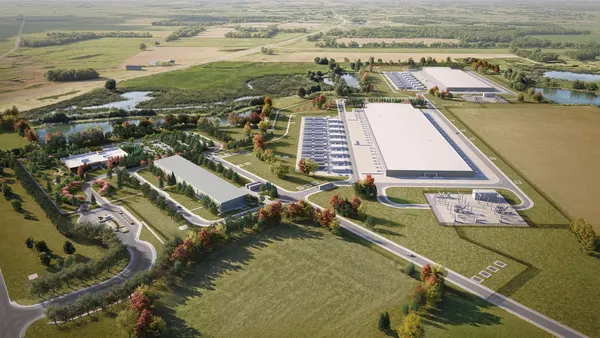A new report from Dodge Data & Analytics has identified a softening in seven of the country's top 20 markets for commercial construction including multifamily, with some of it tied to declines in the multifamily sector.
The study analyzed construction starts rated by dollar value for multifamily and commercial construction, which includes office buildings, retail, data centers, hotels and warehouses. The statistics were collected by the Dodge reporter network and represent a summation of the projects collected for a given period, as opposed to an estimate produced by a sampling methodology, Dodge chief economist Robert A. Murray told Construction Dive.
Despite the slowdown recorded in some areas, 13 markets registered gains in construction starts. Murray said it's important to look back to the boom of the past few years for perspective on the most recent numbers.
"It’s possible to say that both commercial building and multifamily housing are now 'rounding the peak,' after the lengthy expansion this decade," he said. "Since the volume of activity remains close to recent highs, one can say that the results point to an economic deceleration, but it is too early to say that they point towards an economic recession."
The two largest markets in the country — New York City and Washington, D.C. — had drastically different showings. New York metropolitan area starts, at $15 billion, declined 8% from a year ago while the Washington-area starts soared 50%, thanks to a doubling in volume of office construction starts.
The markets in the top 20 showing declines during the first half of 2019 versus a year ago were:
- Seattle ($1.5 billion), down 57%
- Miami ($3.1 billion), down 38%
- San Francisco ($2.1 billion), down 24%
- New York City ($15 billion), down 8%
- Dallas-Ft. Worth ($3.4 billion), down 7%
- Phoenix ($1.5 billion), down 5%
- Houston ($2.5 billion), down 4%
The metropolitan areas in the top 20 showing growth during the first half of 2019 were:
- Cincinnati ($1.4 billion), up 130%
- Nashville ($2.2 billion), up 112%
- Atlanta ($3.4 billion), up 69%
- Washington, D.C. ($7.1 billion), up 50%
- Austin, Texas ($2.6 billion), up 39%
- Philadelphia ($2.5 billion), up 34%
- Minneapolis ($1.8 billion), up 28%
- Portland, Oregon ($1.4 billion), up 22%
- Columbus, Ohio ($1.2 billion), up 20%
- Los Angeles ($3.8 billion), up 14%
- Orlando, Florida ($1.8 billion), up 8%
- Boston ($3.8 billion), up 2%
- Chicago ($3 billion), up 0.4%
Winners and losers
Nationwide, the volume of commercial and multifamily construction starts during the first half of 2019 was $101.4 billion, down 6% from last year’s $107.4 billion. The study's authors partly attribute the decline to a slower pace for multifamily housing, which dropped 13%, while commercial building held steady, clocking in at $58.3 billion compared to $58.1 billion reported during the first half of 2018.
The numbers show that commercial activity has leveled off following eight straight years of growth, Murray said, and that multifamily housing has settled back from 2018's robust amount, "although this year’s volume can still be regarded as healthy by recent standards."
At the same time, there are concerns that multifamily housing is overbuilt in some markets, the economist said, noting that the banking industry continues to take a cautious stance towards multifamily lending.
A look by sector
Drilling down into commercial construction by sector, the report found that office construction starts this year have seen modest expansion, helped by the groundbreaking of large office projects and the continued strength of data center projects. Hotel construction has stayed close to last year’s pace, but warehouse construction has begun to slip and store construction has seen further declines, Murray said.
The next half of the year will rely on many factors including the outcome of the U.S. trade war with China, labor shortages and rising material prices.
"Going forward, a slowing economy would lead to more visible erosion in market fundamentals, which would contribute to a more subdued pace for commercial building starts," he said.
The study provides a snapshot of commercial and multifamily construction activity in the top 10 U.S. markets. Murray said there are many reasons why some regions are slower than others.
For instance, multifamily projects in the Miami market are now retreating, after years of very strong activity supported in part by foreign investment, he said. At the same time, New York, another market where multifamily housing has been supported in part by foreign investment, has yet to see much of a slowdown.
In addition, several markets that have long benefited from the country's economic expansion, such as Dallas-Ft. Worth, San Francisco and Seattle, are now early participants in the moderate slowdown that’s expected to broaden geographically over the next year or two, he added.
Here is a rundown of activity in the top 10 markets:
New York City
8% decline overall (-20% for commercial, 4% for multifamily)
Notable 2019 start: $1.1 billion TSX Broadway Hotel and renovation of the Palace Theater in Times Square
Washington, D.C.
50% increase overall (96% for commercial, 7% for multifamily)
Notable 2019 start: The $300 million CloudHQ data center in Ashburn, Virginia
Boston
2% increase overall (72% for commercial, -41% for multifamily)
Notable 2019 start: The $300 million One Post Office Square addition/renovation
Los Angeles
14% increase overall (8% for commercial, 21% for multifamily)
Notable 2019 start: The $511 million multifamily portion of the $950 million Grand Avenue mixed-use complex
Atlanta
69% increase overall (129% for commercial, 3% for multifamily)
Notable 2019 start: The $550 million Norfolk Southern headquarters building
Dallas-Fort Worth
7% decrease overall (4% for commercial, -7% for multifamily)
Notable 2019 start: A $225 million Google data center in Midlothian, Texas.
Miami
38% decrease overall (-32% for commercial, -42% for multifamily)
Notable 2019 start: The $145 million multifamily portion of the $300 million One West Palm mixed-use complex in West Palm Beach.
Chicago
.4% increase overall (-22% commercial, 42% multifamily)
Notable 2019 start: The $653 million multifamily portion of the $850 million One Chicago Square mixed-use complex
Austin, Texas
39% overall (72% for commercial, 1% for multifamily)
Notable 2019 start: The $375 million Block 185 office tower redevelopment project in downtown
Houston
4% decline overall (8% for commercial, -26% for multifamily)
Notable 2019 start: A $130 million Dollar Tree distribution center in Rosenberg, Texas













